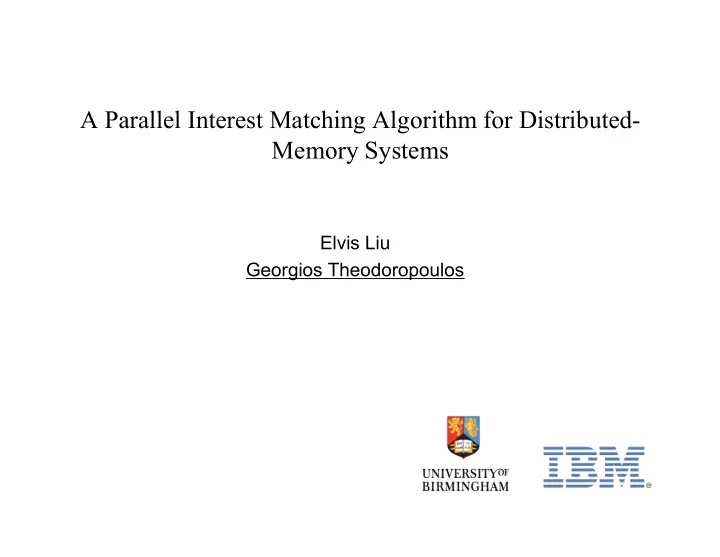

A Parallel Interest Matching Algorithm for Distributed- Memory Systems Elvis Liu Georgios Theodoropoulos
Outline • Introduction – Distributed Virtual Environments (DVE) – Interest Management • Parallel Interest Matching – Algorithm – Load-balancing • Experimental Results • Conclusions 2 Georgios Theodoropoulos
Distributed Virtual Environments (DVE) • Allow multiple users interact in real-time even though they are in different physical locations • Commercial Application – Massively Multiplayer Online Games (MMOGs) • Academic/Military Application – HLA compliant systems • Scalability • Message broadcasting • Interest Management 3 Georgios Theodoropoulos
Seamed Zone-based Schemes • Used by most MMOGs: FFXI, Everquest, GuildWars • Divide the virtual world into zones • Only receive update from one zone • No interest matching is required 4 Georgios Theodoropoulos
Seamless zone-based Schemes • Used by NPSNET • Divide the virtual world into zones • Invisible border • Area of Interest (AOI) • Interest Matching – O(n) for n AOIs 5 Georgios Theodoropoulos
Aura-based Schemes U • Used by MASSIVE • Higher filtering accuracy than zone- based schemes • Interest Matching – O(nm) for n update S regions and m subscription regions S U 6 Georgios Theodoropoulos
Filtering Precision vs. Runtime Efficiency • A trade-off • Zone-based schemes: Good runtime efficiency but poor filtering precision • Aura-based schemes: Good filtering precision but poor runtime efficiency • Existing interest matching algorithms try to deal with this problem 7 Georgios Theodoropoulos
Existing Interest Matching Algorithms • Try to improve the runtime efficiency of interest matching • Multidimensional Binary Trees (Van Hook 1997) • Collision Detection Algorithm (Morgan 2004) • Sort-based (Raczy 2005, Pan 2007, Liu 2005) • All of the above are serial algorithms 8 Georgios Theodoropoulos
Parallel Processing • Serial algorithms – Poor workload sharing • Need of parallel interest matching algorithm • Commercial applications (e.g. MMOGs) usually use shared-memory multiprocessors as servers • Parallel Processing revolution – multicore processors becoming mainstream • Heterogeneous platforms 9 Georgios Theodoropoulos
Parallel Interest Matching • Enhance runtime efficiency by parallel processing • Two phases – First Phase: Spatial Decomposition – Second Phase: Sorting and Matching 10 Georgios Theodoropoulos
Space Decomposition • Decompose the multidimensional virtual space into “flat subdivisions” • Determine the index for each subdivision • Work Unit (WU): the interest matching process within a space subdivision • WU-Node map: contains the information of the space subdivisions that are currently being processed by a node 11 Georgios Theodoropoulos
WU-Node Map • Node A : WU(0,2), WU(1,1), and WU(1,2) 2 Node A Node A Node A • Node B : WU(0,0) and WU(0,1) 1 Node B Node A Node C • Node C : WU(1,0), WU(2,0), and WU(2,1) Node B Node C Node C 0 0 1 2 12 Georgios Theodoropoulos
Space Decomposition (cont.) • At the initialisation stage, an equal number of WUs is assigned to each node • Regions are distributed to different nodes according to the space subdivisions they reside in – If a region lies in multiple space subdivisions that are owned by different nodes, it would be distributed to all of them. 13 Georgios Theodoropoulos
Spatial Hashing • Position and size of a region may be modified dynamically during simulation • Owner node is responsible to determine whether the region in question is changing spaces • Construct a hash table with the indices • Hash all update regions and subscription regions into the hash table – Compute hash value H(v) , for each vertex v of a region 14 Georgios Theodoropoulos
Hash Function • x i : coordinate of vertex on dimension i • l i : Length of subdivision on dimension i 15 Georgios Theodoropoulos
Hashing for Space Subdivisions • A is hashed into (0,1) • B is hashed into (0,0), (0,1), (1,0) and (1,1) • C is hashed into (1,1) and (1,2) • D is hashed into (1,0), (1,1), (2,0) and (2,1) 16 Georgios Theodoropoulos
Hash Table Table Slot (0,0) B (0,1) A,B (0,2) (1,0) B,D (1,1) B,C,D (1,2) C (2,0) D (2,1) D (2,2) 17 Georgios Theodoropoulos
After Hashing • Hash table collision => at least two regions are in the same subdivision • Each slot of the hash table (with collision) represents a WU 18 Georgios Theodoropoulos
Load Balancing • Two algorithms – (1) Redistribute the WUs of an overloaded node to the least loaded node – (2) Redistribute the WUs of an overloaded node to the least loaded neighbour node • Isolated WUs – All adjacent WUs are owned by different nodes – Increases the communication overhead of border crossing • Algorithm (2) decreases the chance of creating isolated WUs 19 Georgios Theodoropoulos
The Second Phase • A sorting algorithm based on dimension reduction is used to determine the overlapping status of the regions 20 Georgios Theodoropoulos
Dimension Reduction • X-axis overlaps: B-C y • Y-axis overlaps: A-C, A-B, B-C, B-D, C-D • 2D overlaps: B-C x Two regions overlap iff their extents overlap on all dimensions 21 Georgios Theodoropoulos
Sorting and Matching • Construct a list of end-points for each dimension • Determine which extents overlap by sorting the lists • Re-sort the lists using insertion sort during runtime 22 Georgios Theodoropoulos
Temporal Coherence • Assumption: Time-steps are small enough that entities do not travel large distance – i.e. Before re-sorting the lists of end-points, they would be nearly sorted • Insertion sort (with original complexity O(n 2 ) ) can be done in linear time 23 Georgios Theodoropoulos
Configuration Scenarios 24 Georgios Theodoropoulos
Experiments • Serial interest matching by sorting algorithm (SIM) • Parallel interest matching with load-balancing algorithm (1) (DIM) • Parallel interest matching with load-balancing algorithm (2) (AltDIM) • Parallel interest matching without load-balancing (DIM\LB) • DIM without communication overhead (DIM\M) • AltDIM without communication overhead (AltDIM \m) 25 Georgios Theodoropoulos
Results 26 Georgios Theodoropoulos
Results 27 Georgios Theodoropoulos
Conclusions • A parallel interest matching approach • Suitable for distributed-memory systems • More computationally efficient than existing (serial) sorting algorithms • High filtering accuracy • HLA DDM compatible • Two load-balancing algorithms 28 Georgios Theodoropoulos
Recommend
More recommend